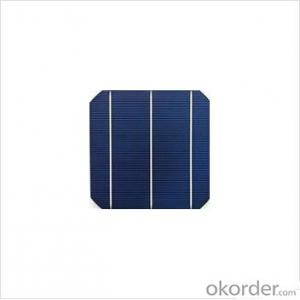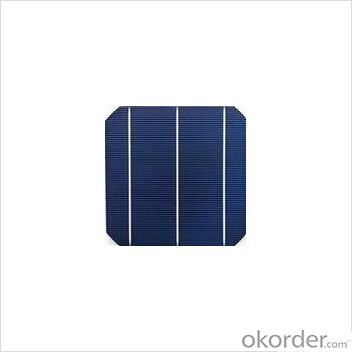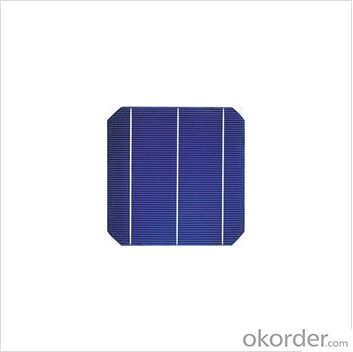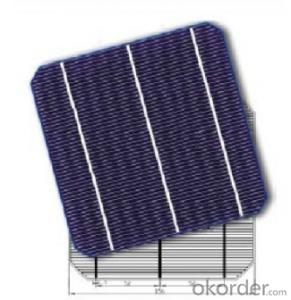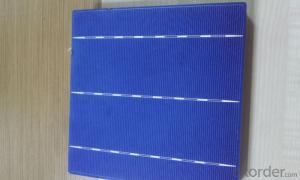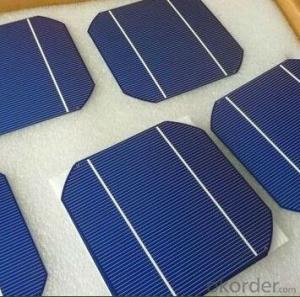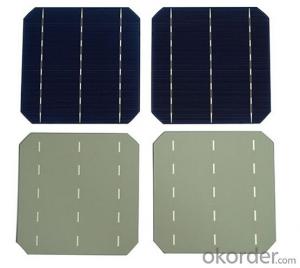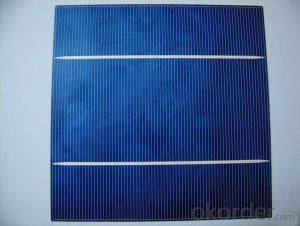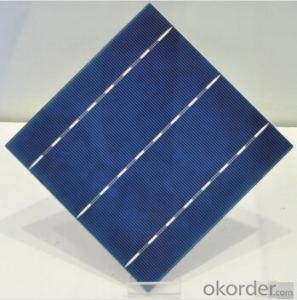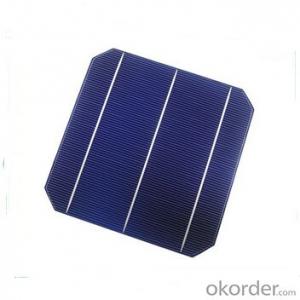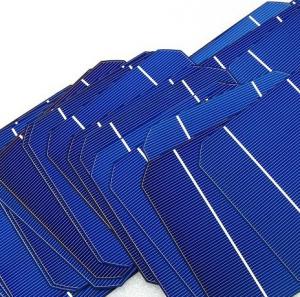High Quality 18.6 Monocrystalline Solar Cells Layers
- Loading Port:
- Shanghai
- Payment Terms:
- TT OR LC
- Min Order Qty:
- 1000 pc
- Supply Capability:
- 1000000 pc/month
OKorder Service Pledge
OKorder Financial Service
You Might Also Like
Solar Cells:
solar cells, when struck by photons of light from the sun, generates an electrical current which can then be used to power DC or AC electrical loads.
A solar cell is made of silicon. Computer chips are made of this same material. Basically, when light strikes the surface of a solar cell some of it is absorbed into the silicon. This light energy bumps the electrons loose and causes energy to flow
Solar cells is made by solar wafer, it has three categories of solar cell right now, monocrystalline polycrystalline and thin film,These cells are entirely based around the concept of PN junction, which is the critical part of solar module, it is the part that can convert the light energy into electricity, the thickness is from 180um to 200um, with even busbars to conduct electricity, textured cell can decrease diffuse reflection; they are often electrically connected and encapsulated as a module. Photovoltaic modules often have a sheet of glass on the front (sun up) side, allowing light to pass while protecting semiconductor wafers from abrasion and impact due to wind-driven debris, rain, hail, etc. Solar cells are also usually connected in series in modules, creating an additive voltage. Connecting cells in parallel will yield a higher current;With high quality and stable quality. Our Cells can greatly improve the performance of Solar Modules.
Features:
High efficiencies up to 16.4%
Proven long term mechanical stability of silicone
Make of highly purified poly silicone
Three bus bars for reduced series resistance and improved module and cell efficiency
Blue anti-reflecting coating ensures improved light absorption and increased efficiency
Acid texturization offers a uniform appearance and virtually invisible crystal structure
Excellent low light behavior for improved energy yield
Specifications
Efficiency code | 1800 | 1820 | 1840 | 1860 | 1880 | 1900 | 1920 | 1940 | 1960 | 1980 | 2000 |
Efficiency(min(%) | 18.0 | 18.2 | 18.4 | 18.6 | 18.8 | 19.0 | 19.2 | 19.4 | 19.6 | 19.8 | 20.0 |
Pmax (W) | 4.30 | 4.35 | 4.40 | 4.44 | 4.49 | 4.54 | 4.59 | 4.64 | 4.68 | 4.73 | 4.78 |
Voc (V) | 0.630 | 0.632 | 0.634 | 0.636 | 0.638 | 0.640 | 0.642 | 0.643 | 0.645 | 0.647 | 0.649 |
Isc (A) | 8.74 | 8.78 | 8.80 | 8.83 | 8.87 | 8.93 | 8.98 | 9.04 | 9.10 | 9.16 | 9.23 |
Imp (A) | 8.27 | 8.37 | 8.44 | 8.49 | 8.55 | 8.61 | 8.67 | 8.73 | 8.79 | 8.85 | 8.91 |
Solar Cells Advantage:
1. High efficiency and High power.
2. Long-term electrical stability.
3. Lowest price and Fastest delivery.
4. Good quality and good service.
5.Bulk supply
6. Good Warranty
7.Big Sale
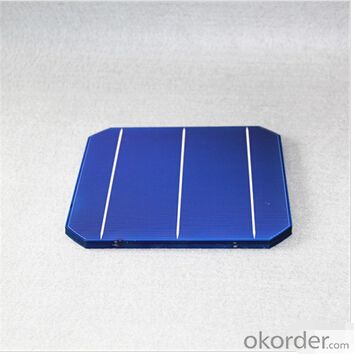
FAQ
We have organized several common questions for our clients,may help you sincerely:
1, What’s price per product ?
A: It’s depends on the quantity, delivery date and payment terms of the order. We can talk further about the detail price issue. Our products is high quality with lower price level.
2, How to make payment?
We accept T/T or L/C.
3, What is your lead time?
Generally 1-5 weeks depends on the order quantity and your specific requirements.
4, Can you do OEM for us?
Yes, we can.
5, How do you pack your products?
We have rich experience on how to pack the panels to make sure the safety on shipment when it arrives at the destination.
- Q: What is the future of solar cell technology?
- The future of solar cell technology looks promising as advancements continue to be made in efficiency, flexibility, and affordability. With ongoing research and development, we can expect to see solar cells becoming more efficient in converting sunlight into electricity. Additionally, innovative designs such as transparent solar cells and solar-powered windows are being explored, expanding the possibilities for integration into everyday objects and infrastructure. As costs continue to decrease, solar energy will likely become more accessible and widespread, contributing to a cleaner and more sustainable future.
- Q: Can solar cells be used in camping or outdoor recreational activities?
- Yes, solar cells can be used in camping or outdoor recreational activities. They are portable and can be used to power various devices such as smartphones, lights, and even small appliances. Solar panels can be easily set up in camping sites to harness energy from the sun and provide a sustainable and convenient power source in remote locations.
- Q: Can solar cells be used in remote areas with no access to electricity?
- Yes, solar cells can be used in remote areas with no access to electricity. Solar cells convert sunlight into electricity, making them an ideal solution for areas with no grid connection. They can provide a reliable source of power for various applications, including lighting, charging electronic devices, and running small appliances, thereby improving the lives of people in remote areas.
- Q: Can solar cells be used for powering remote weather stations?
- Yes, solar cells can be used for powering remote weather stations. Solar cells convert sunlight into electricity, which can be stored in batteries for use when sunlight is not available. This makes them a reliable and sustainable power source for remote locations where access to the electrical grid may be limited. Additionally, solar cells are low maintenance and can operate for long periods without human intervention, making them an ideal choice for powering weather stations in hard-to-reach areas.
- Q: What is the lifespan of a solar cell?
- The lifespan of a solar cell can vary depending on various factors, but on average, solar cells have a lifespan of around 25 to 30 years. However, with proper maintenance and care, solar cells can even last longer, sometimes up to 40 years or more.
- Q: Can solar cells be used for powering electric vehicle charging stations?
- Yes, solar cells can be used for powering electric vehicle charging stations. Solar panels can convert sunlight into electricity, which can then be used to charge electric vehicles. This renewable energy source is ideal for charging stations as it reduces reliance on traditional power grids and reduces carbon emissions.
- Q: How do solar cells impact job creation?
- Solar cells impact job creation in several ways. Firstly, the installation and maintenance of solar panels require skilled workers, creating job opportunities in the renewable energy sector. Additionally, the manufacturing of solar cells creates employment in the production and supply chain. As the demand for solar energy continues to grow, more jobs will be created in research, development, and sales. Overall, the adoption of solar cells stimulates job growth and contributes to the transition towards a green economy.
- Q: What is the impact of solar cells on reducing air pollution from power generation?
- Solar cells have a significant impact on reducing air pollution from power generation. By harnessing energy from the sun, solar cells produce electricity without emitting harmful pollutants such as carbon dioxide, sulfur dioxide, or nitrogen oxides. This clean and sustainable energy source helps to mitigate the negative effects of traditional fossil fuel-based power generation on air quality, thus contributing to a healthier environment and reducing the overall carbon footprint.
- Q: How do monocrystalline solar cells differ from polycrystalline solar cells?
- Monocrystalline solar cells are made from a single crystal structure, typically silicon, which allows for higher efficiency and performance in converting sunlight into electricity. On the other hand, polycrystalline solar cells are made from multiple crystal structures, resulting in a lower efficiency but a more cost-effective option.
- Q: Can solar cells be used on wearable technology?
- Yes, solar cells can be used on wearable technology. Advances in technology have made it possible to integrate solar cells into small and flexible materials, making them suitable for use in wearable devices. These solar cells can generate and store energy from sunlight, allowing wearable technology to become self-sustaining and reducing the need for frequent recharging or battery replacements.
Send your message to us
High Quality 18.6 Monocrystalline Solar Cells Layers
- Loading Port:
- Shanghai
- Payment Terms:
- TT OR LC
- Min Order Qty:
- 1000 pc
- Supply Capability:
- 1000000 pc/month
OKorder Service Pledge
OKorder Financial Service
Similar products
Hot products
Hot Searches
Related keywords
